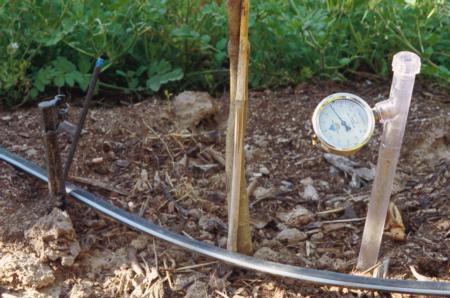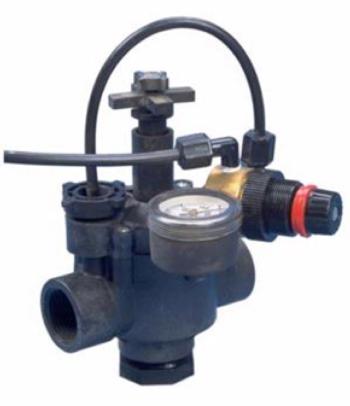Summer 2014: Retrospective on improving irrigation management
Regional Report for Santa Cruz and Monterey Counties by Steve Tjosvold
In the spring of 1983, I planted myself in Watsonville as a new farm advisor. I needed to determine the major issues facing the ornamentals industry, prioritizing my efforts to address the most important issues with research and educational programs. Many growers were producing cut carnations at the time, and the carnations were being attacked by fusarium wilt, a serious soil-borne disease. Upwards of 40% of a carnation crop could be killed in a two-year crop cycle. So I began field research with growers and plant pathologists on soil disinfestation treatments, fungicides and biological control agents to fight this disease. At the same time, salt water intrusion into underground aquifers was starting to be detected in coastal wells from Castroville to Watsonville. In 1984, the Pajaro Valley Water Management Agency was formed to begin to address these concerns. Today, carnation production and its associated diseases are essentially non-existent because markets have changed dramatically. But water quality and availability issues are still significant. With the current drought, of course, the needs of managing irrigation water is more important than ever. In this article, I look back to the research work we did then and how it applies today.
My colleague Kurt Schulbach and I began research to improve water use in greenhouses, initially focusing on cut roses which was a crop commonly grown in this area. We developed an innovative way of measuring a rose crop’s water needs with an evaporation pan placed in the greenhouse. The pan results were calibrated with tensiometers. This is a simple instrument that is placed in the soil and measures soil moisture tension—a guage of the wetness / dryness of the soil relative to the needs of the plant. We demonstrated how tensiometers could be monitored to help determine when rose plants were stressed. We found that roses really liked to be watered frequently; soil tensions needed to be below 10 centibars or plants were stressed and flower production fell. Today, tensiometers (fig. 1) and other soil moisture measurement sensors are widely available but still mostly unknown or underutilized. To that point, at a recent irrigation management meeting, a grower noted he first learned of tensiometers while visiting flower nurseries in Bogota, Colombia!

Tensiometers are usually placed in a field soil in sets of two: one is placed to measure soil water tension in the root zone and one placed below the root zone to detect water movement below the roots. In highly-amended porous field soils, container soils, or sandy soils typically preferred in ornamental production, you want to use the tensiometers that can measure low tensions (such as the Irrometer LT model).
If you are a newcomer to the use of tensiometers, you might first try installing a set of tensiometers and irrigate for several weeks as you normally do. Record tensiometer readings for at least 3 weeks. What you might see is that irrigations begin when the root zone tensiometer measure around 10 centibars or lower. Crops should be irrigated before they are stressed and certainly before they wilt. In general, tensions as low as 5 centibars would offer the plants a moisture stress-free environment. With more records and some evaluation, a grower could start using the tensiometers to time irrigations more accurately. With added accuracy and reduced water applications comes the importance of insuring that enough water is applied at each irrigation to leach accumulated salts and compensate for imperfect irrigation systems. Imperfect irrigation systems relate to another major project completed over 20 years ago.
In that project, we evaluated 23 micro-irrigation systems used in greenhouse cut flower production. The ability of the micro-sprinklers and drip systems to apply water uniformly varied widely. The drip tape systems usually provided very uniform application of water as measured by a common measure called the distribution uniformity (DU). With drip tape, DU was measured at upwards of 96%, while the perimeter micro sprinkler systems averaged mostly between 60% and 70%. We were able to demonstrate an important concept in irrigation management. The lower the DU, the more water is required to meet crop needs. The amount of extra water needed to ensure adequate irrigation could be estimated by dividing the water requirement by the DU. Relative to a system with a perfect 100% uniformity, a system with a DU of 85% requires about 18% more water than the crops need to make sure that the drier areas receive enough water (1.0/0.85 = 1.18). An irrigation system with a DU of 51% (1.0/0.51=1.96) would require nearly 80% more water than one with a uniformity of 85%. Often, this amount of extra water is not applied and in some areas there may be yield losses due to water stress. This research illustrated significant water savings with drip tape irrigation and preceded a big shift from sprinkler irrigation to drip and other micro-irrigation systems in cut flowers and other crops.
Another observation in our evaluation demonstrated an important concept about irrigation design that is still important today. In general, we observed the flow rates in the sprinkler perimeter systems were too high for the ¾-inch laterals used in some sprinkler irrigation systems and it caused large friction losses. In one system, the pressure was 75 psi at the pump but only 2 psi at the end of the sprayer lines. This pressure drop was caused by friction losses through valves, pipe bends and small diameter pipe. As a result, the average DU measured in the sprinkler irrigation systems was only 70%.
Although large pressure losses in the mainlines do not necessarily result in low distribution uniformity, these losses increase pumping costs and waste energy. Large friction losses in mainlines can be compensated for by using pressure regulators (fig. 2) that even out the water flow to each separately controlled area. Another method to compensate for large pressure losses in the mains is to adjust the irrigation set times. For example, in areas of the greenhouse or nursery where pressures are low, the run time can be increased until the total amount of water applied to the irrigation block is the same as in the high-pressure areas.

Automatic timing devices rather than manual operation of solenoids could significantly improve uniformity. It was noted many times that a worker operating the solenoid valves was distracted and thus not keeping an eye on the timing of the irrigation. Although not common, pressure compensating valves along water mains, when they are set properly, could significantly increase uniformity.
Plugging of the outlets was the other major cause of low uniformities. The mainlines in most of the systems were iron pipe and as a result rust flakes were commonly found plugging emmiters. Chemical precipitates and sand were often the cause of plugging in other systems. Only the drip systems utilized water filtration, and the overall higher uniformity of these systems demonstrates the value of filtration. A regular maintenance program, including chemical treatment and flushing of the laterals, will also help keep systems clean and reduce plugging without the damage often caused by manual cleaning.
The Resource Conservation District of Santa Cruz County (RCD) with various sponsors will be offering a program in the fall of 2014 to evaluate irrigation systems with the Mobile Irrigation lab, as we did over 20 years ago. Contact the RCD (http://www.rcdsantacruz.org/) for further information.
Steven A. Tjosvold
Farm Advisor, Environmental Horticulture
UC Cooperative Extension Santa Cruz County
1432 Freedom Boulevard
Watsonville, CA 95076-2796
(831)763-8013 phone, (831) 763-8006 fax
satjosvold@ucanr.edu
http://cesantacruz.ucanr.edu/
References
Tjosvold SA, Schulbach KF. 1991. How to reduce water use and maximize yields in greenhouse roses. California Agriculture 45(3):31-32.
http://californiaagriculture.ucanr.edu/landingpage.cfm?article=ca.v045n03p31&fulltext=yes.
Schulbach KF, Tjosvold SA, Kasapligil, D. 1999. Improving irrigation systems conserves water in greenhouse-grown cut flowers. California Agriculture 53(2):44-48.
http://californiaagriculture.ucanr.edu/landingpage.cfm?article=ca.v053n02p44&fulltext=yes/.












